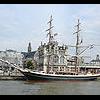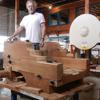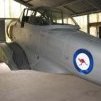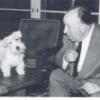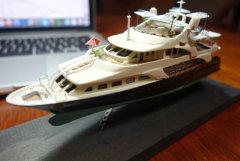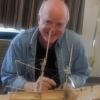MORE HANDBOOKS ARE ON THEIR WAY! We will let you know when they get here.
×
-
Posts
461 -
Joined
-
Last visited
Reputation Activity
-
 Chasseur reacted to Stockholm tar in Sherbourne by Stockholm tar - Caldercraft - 1/64
Chasseur reacted to Stockholm tar in Sherbourne by Stockholm tar - Caldercraft - 1/64
Before I move on to the fittings I should first say a word about the stern, as I found this was one of the most difficult areas to work on. The horizontal planking of the stern piece, both inside and out, was straightforward enough, but I seem to remember that the sloping counter below it presented a few problems.
This was again planked horizontally, and I glued a raised plank around the edge to make something of a feature. This looked quite good, but I remember I had to make two small triangular-shaped pieces of plank to fill in two odd-shaped gaps, on either side at the top of the counter. I can’t now recall exactly why this was necessary, but anyway they were made and duly fitted in place. Although rather dark in the photograph, the one on the starboard side can be made out. As with the upper part of the hull, the counter was left natural.
I wanted to fit a rather more substantial transom rail than that shown on the box lid. This had to bend in two directions, the first following the shape of upper edge, the other the curve fore-and-aft. Because of this ’double bend’, I opted to use a piece of the thin maple planking, and it fitted quite well. The only problem when glued in place was the juncture of the transom rail with the bulwarks, which produced something of an odd angle with the bulwark. I eventually decided that the simplest solution to hide what would have been an unsightly join, was to fit a pair of davits over the stern, made from some spare pieces of wood and which I had seen in some pictures of cutters. Four sheave holes were drilled in the outer end for the falls, but I didn’t rig them although cavels were provided inside bulwarks, just below the swivel guns, to belay them. I should mention at this point that the main rail was put on in three pieces of about the same length, on each side. I found that when dry fitting it, the length made it rather unwieldy, and thought that when gluing, to much would be left to chance! My only regret is that I didn't scarf the joint. However, you can't see the join, as one part of a comedy double-act used to say when referring to his oppo – although you can if you look closely!
The lower (double) sheet block, for the main sheet, was fixed to a timber fitted between the inner standards supporting the transom, two cleats being fixed to them for belaying purposes. Moving forward, I decided there would have to be some sort of storage for the balls for the swivel guns, and settled on a couple of lockers, one each side of the tiller, the starboard one having its lid open. Since the lockers were oblong and of a reasonable size I divided them in half, the outer compartment housing the ammunition. The other side of the open locker contains the coiled lead line, with the lead on the top. You can just see this in the third photograph. (In my minds eye, the larboard locker also contains the swivel ammunition in the outer compartment, and the log line in the inner.)
Whilst on the subject of the swivels, I decided to reduce their number to two each side at the stern, similar to those at the bow – rather than fitting the three as envisaged in the kit. This was both because I thought three looked rather too many, and I could also imagine the crews getting in each other’s way – especially when trying to get the ammo from my lockers! I discarded the kit swivel supports, in favour of my own make – which are actually made from two eyebolts bent at the top, and glued back to back. The handles are small nails cut off and glued to the underside of the gun.
Like many building this kit I also thought a new tiller was needed, since I too wasn’t happy with the one provided. Made to a scale length of ten feet, as given for the Alert, I laminated it from several layers to get the correct shape, using nails fixed to a board. When dry, it was rounded with sandpaper, and a tenon was formed in the ’outboard’ end, which then fitted into a squared hole in the rudder head. This was a much better, and more accurate, arrangement than the fitting on the kit tiller – which rather strangely, I thought, completely encircled the rudder head. I then glued thin paper strips around the tiller at the rudder end, and on the rudder head itself, to represent strenthening bands. Some tan rigging thread was glued around the business end, to enable the helmsman to ’get a grip’, as it were. (I had originally thought of fashioning a turk’s head knot on the end, for decoration, however I’m afraid both the scale and the tediousness of forming it, defeated me.) To stop the tiller from swinging, I clove-hitched the middle of a line to the tiller, the ends then being belayed to one of the posts on each bulwark, and finished off with rope coils. I glued some ’treads’, for the helmsman’s feet, to the deck in a fan shape that followed the arc of the tiller.
Moving forward, we come to the small structure of the cabin companion. This is not provided in the kit, the space being merely occupied by the aftermost of the small hatches. I found this rather wanting, and thought the young CO deserved a more impressive entrance to his cabin! The companion was made from four pieces of ply from the kit frame surrounds, and given a sloping roof, which has a raised ’hinge’ across it. The after side has two doors each of which, although they don’t open, is provided with a knob!
Next time: more fitting details.
-
 Chasseur reacted to Stockholm tar in Sherbourne by Stockholm tar - Caldercraft - 1/64
Chasseur reacted to Stockholm tar in Sherbourne by Stockholm tar - Caldercraft - 1/64
Before I move on, I omitted to mention a couple of items in the previous post. First, I wasn’t particularly happy with the stand provided and thought of various other types, including my own wooden one, a version made from perspex (which can often be very effective), or perhaps employ couple of pedestals (either brass or wood). I deliberated on this for some time before I was more-or-less forced, by progress on the model, to make a decision. In the end, I’m afraid, took the easy way out and decided to go with the stand supplied – although it was somewhat modified!
As can be seen, I cut down the height of the supports to around the bilge area, since this was where maximum support was needed, with rather more being taken from the front supports than the rear. This gave it a much better appearance, removed the somewhat intrusive extensions up the sides of the model, and didn’t affect the stability. A wooden crossbar was then fixed between the supports, angled on the top face to match the that of the keel, and with two small holes drilled through it in appropriate positions. Corresponding holes were drilled in the keel and I found two suitable screws. Then with four thin strips of adhesive padding material added to the arms to protect the model, and following a light varnishing, the stand was screwed to the hull. I decided to leave the colour as it was, being less intrusive – to my mind, the stand should be as ’invisible’ as possible so as not to detract from the model itself. I added the lettering, ’HM cutter ’Sherbourne’ – 1763’ at a later date.
The rudder was planked with three planks on each side, with paper strips around it at suitable points to simulate iron bands. The planks I chose were a little marked, which gave the rudder a old ’worn’ look. I fitted an eyebolt on its after side. Thin strips of black paper simulated the pintle and gudgeon straps. With that well-known concept known as hindsight, I now think the rudder would perhaps have looked better tapered, but there it is.
The last photo also shows the metal lettering of the name, the individual letters being glued on separately. Since I had painted the stern yellow ochre, I thought black lettering would look rather effective. However, to actually position the lettering itself took a little thinking about to get the spacing right. Rather than begin on the left side which would perhaps be usual, but which might very likely end up with too much space to the right, I decided to start with the central letters over the rudder, and work out to each side. Working by eye this method kept things equal, and resulted in the same amount of space on each side of the name. Whilst on the subject, I have not managed to find out how the actual name came about. There is a town named Sherbourne, in the English county of Dorset I used to live in, but I rather suspect the cutter is perhaps named after an Admiralty or Dockyard official. It would be interesting to know.
So, now to the deck. With the gunport strips fitted, the instructions then said something like, ’with a pair of pliers, twist off the heads of the frames above deck level’. What?! I must have read that a few times, to fully understand that’s what they really meant – and I felt that there was no way I was going to do actually that, without causing some serious damage! It appeared to me that it would also leave an unsightly break, which I would then have to spend time tidying up with sandpaper, even a file. Instead, I came up with another solution. Before fitting the gunport strips, I decided to saw about half-way through the frame tops at deck level from the side, with a fine toothed model saw, and to use only the minimum amount of glue in fixing the strips. I reckoned I would then only need to use minimum force to remove the frame tops. It worked well, they came away with very little effort – and I expended very little effort in tidying up the remains. I seem to remember that I planked the bulwarks both inside and out, using scale length planks, as I progressed, in order to strengthen the gunport strips. These were quite weak at this point with little support, merely being glued to the upper edge of the wale. I actually used the thin strips of, I think maple, to plank the inner bulwarks (although I think they were supposed to be used for the deck) since they fitted round the bow more easily, and were painted red.
I decided to more or less follow the colour scheme of the Alert on the cover of the AOTS book, for the outer bulwark planking. I opted to use yellow ochre for the planking, with red in the gun and sweep ports, black for both wales, with a line of blue between the upper wale and the capping rail.
The deck was laid in three-step-butt fashion, working from aft forward and from the centre out, the outer planks being joggled into the margin plank. One side, and one end, of each scale plank were ’caulked’ with black rigging cord. The same cord was also used to caulk around the hatches.
Next time: the various fittings.
-
 Chasseur got a reaction from ggrieco in Young America 1853 by EdT - FINISHED - extreme clipper
Chasseur got a reaction from ggrieco in Young America 1853 by EdT - FINISHED - extreme clipper
*Simply Outstanding work* ...Ed
As a ship in bottle modeler I always pick up tips and techniques from Gents like yourself!
-
 Chasseur reacted to rwiederrich in Young America 1853 by EdT - FINISHED - extreme clipper
Chasseur reacted to rwiederrich in Young America 1853 by EdT - FINISHED - extreme clipper
Care to share those other pictures Ed? I for one would love to see them. If you have not already posted them.
Rob
-
 Chasseur reacted to EdT in Young America 1853 by EdT - FINISHED - extreme clipper
Chasseur reacted to EdT in Young America 1853 by EdT - FINISHED - extreme clipper
I am quite sure these were the builders models. They are in the Smithsonian collection. I have other pictures of them.
Ed
-
 Chasseur reacted to ggrieco in SS Kaiser Wilhelm der Grosse 1897 by Mirabell61 - FINISHED - scale 1:144 - POF - first German four stacker of the Norddeutscher Lloyd line
Chasseur reacted to ggrieco in SS Kaiser Wilhelm der Grosse 1897 by Mirabell61 - FINISHED - scale 1:144 - POF - first German four stacker of the Norddeutscher Lloyd line
Happy Birthday Nils!!
I've been away too long and you've been busy. I am amazed at the amount of detail you are putting into this model. Just incredible!
-
 Chasseur reacted to Mirabell61 in SS Kaiser Wilhelm der Grosse 1897 by Mirabell61 - FINISHED - scale 1:144 - POF - first German four stacker of the Norddeutscher Lloyd line
Chasseur reacted to Mirabell61 in SS Kaiser Wilhelm der Grosse 1897 by Mirabell61 - FINISHED - scale 1:144 - POF - first German four stacker of the Norddeutscher Lloyd line
little update....
the first of the six machine room skylights (dry fit), not quite complete...
Nils
-
 Chasseur reacted to Mirabell61 in SS Kaiser Wilhelm der Grosse 1897 by Mirabell61 - FINISHED - scale 1:144 - POF - first German four stacker of the Norddeutscher Lloyd line
Chasseur reacted to Mirabell61 in SS Kaiser Wilhelm der Grosse 1897 by Mirabell61 - FINISHED - scale 1:144 - POF - first German four stacker of the Norddeutscher Lloyd line
Thank your greeting and your nice compliment Martin,
I`m very pleased if you look in regulary and you lke it....
the shipyard workers are looking for a place where they wo`nt be disturbed when having their lunch.....
Nils
-
 Chasseur got a reaction from mmdd in SS Kaiser Wilhelm der Grosse 1897 by Mirabell61 - FINISHED - scale 1:144 - POF - first German four stacker of the Norddeutscher Lloyd line
Chasseur got a reaction from mmdd in SS Kaiser Wilhelm der Grosse 1897 by Mirabell61 - FINISHED - scale 1:144 - POF - first German four stacker of the Norddeutscher Lloyd line
Happy Birthday Nils and good to see the Brass Meister is back at it!
Blessings on your day*
-
 Chasseur reacted to ggrieco in Muscongus Bay Lobster Smack by hexnut - Midwest Products - 1:24 - 1st wooden ship build
Chasseur reacted to ggrieco in Muscongus Bay Lobster Smack by hexnut - Midwest Products - 1:24 - 1st wooden ship build
Incredible stuff here! Your CAD work, your sketches and your woodworking skills are impressive. I hope you don't mind me filling your inbox with likes. I have been meaning to go back and read your whole build and finally got the chance. Only wish I had followed along sooner. I hope we see a continuation soon, I will be following.
-
 Chasseur reacted to hexnut in Muscongus Bay Lobster Smack by hexnut - Midwest Products - 1:24 - 1st wooden ship build
Chasseur reacted to hexnut in Muscongus Bay Lobster Smack by hexnut - Midwest Products - 1:24 - 1st wooden ship build
Dee dee and Mario, thanks for all the help. Mario, you have already provided great inspiration for those of us stumbling along in your footsteps...
Sea Dog, thanks for the compliment--I draw stuff as part of my job, so I'm pretty used to working things out visually.(pixels are cheaper than wood) Although I've already accumulated a large scrap pile for what is supposed to be a beginner kit. (No fault of the manufacturer, just my inability to leave well-enough alone.)
-
 Chasseur reacted to cog in Syren by JesseLee - FINISHED - Model Shipways - scale: 1:64
Chasseur reacted to cog in Syren by JesseLee - FINISHED - Model Shipways - scale: 1:64
Nice solution Jesse,
I wouldn't have thought of it (don't have guitar string, but could have use the cable for a bicyle's handbrakes come to think of it).
And another person helped out ... you are an amazing person, with such an open heart, I feel privileged to get to know you for as far that is possible on a forum
-
 Chasseur reacted to flyer in SS Kaiser Wilhelm der Grosse 1897 by Mirabell61 - FINISHED - scale 1:144 - POF - first German four stacker of the Norddeutscher Lloyd line
Chasseur reacted to flyer in SS Kaiser Wilhelm der Grosse 1897 by Mirabell61 - FINISHED - scale 1:144 - POF - first German four stacker of the Norddeutscher Lloyd line
Hallo Nils
Alles Gute zum Geburtstag!
peter
-
 Chasseur reacted to rwiederrich in Young America 1853 by EdT - FINISHED - extreme clipper
Chasseur reacted to rwiederrich in Young America 1853 by EdT - FINISHED - extreme clipper
Ed..I wasn't sure that it was the builders model..but it was very large and ...did you zoom in on the cheek plates to see the ornamental designs? Beautiful.
Unfortunately Donald McKay,s half model of the Glory of the Seas was not available for viewing.
I hope you enjoy the image.
Rob
-
 Chasseur got a reaction from PeteB in SS Kaiser Wilhelm der Grosse 1897 by Mirabell61 - FINISHED - scale 1:144 - POF - first German four stacker of the Norddeutscher Lloyd line
Chasseur got a reaction from PeteB in SS Kaiser Wilhelm der Grosse 1897 by Mirabell61 - FINISHED - scale 1:144 - POF - first German four stacker of the Norddeutscher Lloyd line
Happy Birthday Nils and good to see the Brass Meister is back at it!
Blessings on your day*
-
 Chasseur got a reaction from Martin W in SS Kaiser Wilhelm der Grosse 1897 by Mirabell61 - FINISHED - scale 1:144 - POF - first German four stacker of the Norddeutscher Lloyd line
Chasseur got a reaction from Martin W in SS Kaiser Wilhelm der Grosse 1897 by Mirabell61 - FINISHED - scale 1:144 - POF - first German four stacker of the Norddeutscher Lloyd line
Happy Birthday Nils and good to see the Brass Meister is back at it!
Blessings on your day*
-
 Chasseur got a reaction from Omega1234 in SS Kaiser Wilhelm der Grosse 1897 by Mirabell61 - FINISHED - scale 1:144 - POF - first German four stacker of the Norddeutscher Lloyd line
Chasseur got a reaction from Omega1234 in SS Kaiser Wilhelm der Grosse 1897 by Mirabell61 - FINISHED - scale 1:144 - POF - first German four stacker of the Norddeutscher Lloyd line
Happy Birthday Nils and good to see the Brass Meister is back at it!
Blessings on your day*
-
 Chasseur reacted to JesseLee in Syren by JesseLee - FINISHED - Model Shipways - scale: 1:64
Chasseur reacted to JesseLee in Syren by JesseLee - FINISHED - Model Shipways - scale: 1:64
Haven't got a lot done on the ship since Hurricane Matthew came through. Things are still bad here in North Carolina. People have drowned. Farms are lost. Livestock lost. Many homes flooded. Been letting some family over to get showers. But I have been working a little.
Started constructing the 2 cannon. Tried to figure out how to sand the laser cut wheels provided all the same. Played with a few ideas & came up with this. Found an old piece of guitar string left behind by our son a few years ago. The wheels screwed snug on the wrapped wire & held just enough to get them all uniform. I achieved this by rolling them all on sandpaper with my fingers. it rounded them up without taking too much off. Painted them while they were still on the wire (didn't pain the sides). Test fitting them on the partially built carriages.
Jesse
-
 Chasseur reacted to Jond in Bluenose by Jond - 1:24 scale - RADIO - Racing Schooner
Chasseur reacted to Jond in Bluenose by Jond - 1:24 scale - RADIO - Racing Schooner
I wanted to add a few details that I left out involving getting the rails and deck on and getting the hull in shape. [ rescued ]
I mentioned earlier that the "crude" pond yacht method gave us a 1-1/2 inch keel which made the bow stems ' awkward' and ugly. With no real keel meant for detail.
first of all I built up the rails and rough fit the bow sprit . Here I have removed the spar and need to build out the bow exterior.
I used small piece of scrap wood as a base. I then chose to add on a bow stem to make the full assembly work out. It is the stem that supports the bowsprit and gives that graceful look. In this picture it looks like I should have gone further with the added stem to perhaps have a thin keel. Because that would effectively enlarged the boat, I chose to compromise and add it here for the detailing and move on.
Here all is in place and the 1st putty is in place. I used hammered copper #14 wire for the hawse ring. I can tell you know that paint, sand putty and paint was done twice up here. Next comes the monkey rail.
I used the buildup method of damp wood and pins to dry and hold during glue up.
I kept the pins in place , snipping and driving them home after glue set for strength.
for the curved section at he forward end of the monkey rail, I use 1/32" plywood soaked and dry wrapped around pipe for the right diameter. I glued and screwed to hold shape then removed screws to finish. This is another example where this detail is easier at the large scale.
for the transom, I made a pattern in 3/8" scrap plywood off the lower railand wrapped laminated and soaked 3 layers of 1/32" birch plywood. After drying I glued and re wrapped the layers tight on the form. The lower and top rails are 1/8 plywood at the transom and built up two layers, side by side 1/4" by 1/16" again for the rails.
I mentioned before that the first coat of paint on the hull was indeed only that. Building up the rails made is necessary to smooth out the whole outside top edge with putty and get ready to paint. I will get the chain plates on next after painting out the rails and then repaint the hull. all for now cheers
-
 Chasseur got a reaction from FriedClams in Bluenose by Jond - 1:24 scale - RADIO - Racing Schooner
Chasseur got a reaction from FriedClams in Bluenose by Jond - 1:24 scale - RADIO - Racing Schooner
Excellent Jond. I really love when craftsmen add figures to a ship model. The figures make the ship come alive and they tell a story. G scale seems to work perfectly .... way to go!
-
 Chasseur got a reaction from mtaylor in Bluenose by Jond - 1:24 scale - RADIO - Racing Schooner
Chasseur got a reaction from mtaylor in Bluenose by Jond - 1:24 scale - RADIO - Racing Schooner
Excellent Jond. I really love when craftsmen add figures to a ship model. The figures make the ship come alive and they tell a story. G scale seems to work perfectly .... way to go!
-
 Chasseur got a reaction from Jond in Bluenose by Jond - 1:24 scale - RADIO - Racing Schooner
Chasseur got a reaction from Jond in Bluenose by Jond - 1:24 scale - RADIO - Racing Schooner
Excellent Jond. I really love when craftsmen add figures to a ship model. The figures make the ship come alive and they tell a story. G scale seems to work perfectly .... way to go!
-
 Chasseur reacted to EdT in SS Kaiser Wilhelm der Grosse 1897 by Mirabell61 - FINISHED - scale 1:144 - POF - first German four stacker of the Norddeutscher Lloyd line
Chasseur reacted to EdT in SS Kaiser Wilhelm der Grosse 1897 by Mirabell61 - FINISHED - scale 1:144 - POF - first German four stacker of the Norddeutscher Lloyd line
Another little known historical fact: When Orville and his sister Katherine Wright sailed to France to join their brother Wilbur who had been in negotiations with the French government for the sale of the Wright brothers "flyer" in early 1909, they sailed on the Kaiser Wilhelm der Grosse. Sorry, but the plane went over earlier with Wilbur on the Campania.
Ed
-
 Chasseur reacted to popeye the sailor in Skipjack by michael mott - 1/8th scale - SMALL - 19 foot open launch
Chasseur reacted to popeye the sailor in Skipjack by michael mott - 1/8th scale - SMALL - 19 foot open launch
ouch! how in the heck did that happen?!?!?!?! I'm sure you'll get 'er sorted out before time to put here back into the water second that.......get better!
can't wait to see what the project is
-
 Chasseur reacted to Jond in Bluenose by Jond - 1:24 scale - RADIO - Racing Schooner
Chasseur reacted to Jond in Bluenose by Jond - 1:24 scale - RADIO - Racing Schooner
Jeff and Michael
thanks for your comments
more coming as my build is currently still ahead of my posting. I am struggling making the break levers for the anchor winch and getting chain to stay on gears. The figures came from my brothers model train shop. I am told they are g scale I think. Not sure what is in the brief case of the commuter I have used so far. I will be adding some standing figures that are not painted.... a whole new area.
cheers


